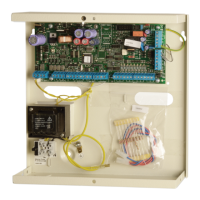16 / 18 P/N 466-5570 (EN) • REV E • ISS 22MAR22
covers shall be continuously monitored by the intruder
detection system to detect unauthorised opening.
It is recognised that not all enclosures have the provision to
accept conduit. Where this is the case, screened cable may be
installed between the conduit terminating box and the
equipment. The exposed screen shall be kept as short as
possible at the point of entry into enclosures and shall be
terminated at one end to a cross bonded main earth point.
Wiring associated with alarm transmission paths (ATPs) shall
be concealed as far as is practical and means provided to
prevent the inadvertent disconnection of plug-in transmission
connections (for example, telephone socket with a locking
facility). When ordering a dedicated connection for the
supervised premises transceiver (SPT) from a
telecommunications provider, it is recommended that in
addition to the telephone socket outlet, a ‘block terminal’ is
fitted adjacent to the enclosure containing the SPT for
diagnostic purposes.
Where the routing of ATP wiring may be exposed to potential
lightning strikes, consideration should be given to the use of
additional lightning protection devices. Many SPT devices have
electrical transient suppression fitted which often requires the
SPT to have an electrical earth connection. Confirmation
should be sought from the alarm company that the earth
connection has been made correctly to a known good earth
potential. Failure to do so will result in the non-operation of the
transient protection device and a very high probability of a
catastrophic failure of the SPT.
Any landline-based alarm transmission path (Ethernet, PSTN,
etc.) shall have a cable interconnection between the SPT and
the first suitable alarm transmission network termination point
within the premises. This interconnection shall be made in one
continuous run and use termination components (or housings)
that protect against cable removal without the use of a tool.
The connection to the alarm transmission network shall be
made in such a manner that where non-alarm related
apparatus/services are also connected to that network, they do
not prevent, or interfere with, the correct operation of the alarm
transmission system.
INCERT policy
The required settings for INCERT Grade 2 are all EN 50131
Grade 2 required settings, and settings for INCERT Grade 3
are all EN 50131 Grade 3 required settings, with the following
modifications:
• 1.2.9.1.m.n.2 Batt.test freq: Everyday
• 8.2.1 User code required: Enabled
• 8.3.3 Alarm list: Disabled
• 8.4.1 RTS options: FTC and Battery fault set to On
• 8.4.2 Inhibit includes: Battery fault must be set to Access
level 2
• 8.4.6 Pending alarms: Enable EN 50131
• 9.3.n.2 Line fault: Set to If used or On
• 9.3.n.7.7 Line fault: Set to On
See also “EN 50131 Grade 2” on page 12 and “EN 50131
Grade 3” on page 13.
For INCERT T031 installations the following devices should be
mounted in metal housings only: ATS7700, ATS7200E,
RC213, ATS1810, ATS1811, ATS1202, ATS1330, ATS1740,
ATS1743.
SES policy
Depending on the SES default chosen, the following SES
settings are required on top of EN 50131 Grade 2 / Grade 3.
• Take care that a proper dedicated panic button is used
(which cannot be pushed by accident).
• Automatic unsetting is not allowed.
• For SES Grade 3 is not allowed to program GPRS
communication as primary CS, it is only allowed in
Grade 2.
• The table below indicates the required polling intervals for
SES Grade 2 and Grade 3.

